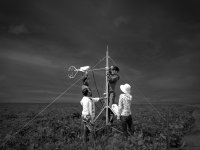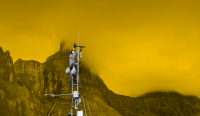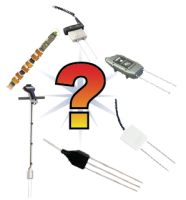Sensor Topics Your source for sensor-related articles
Displaying 1 - 20 of 26 articles
Seeing the Unseen: 3 Best Practices to Optimize Your Eddy Flux Measurements
Author: Aspen Nielsen | Last Updated: 10/14/2025 | Comments: 0
What is around you that you cannot see with your naked eye? This question might invoke images of distant galaxies, known only by state-of-the-art telescopes. Or, perhaps, you think about infrared or ultraviolet light, only visible through specialized cameras. Maybe microorganisms studied through a microscope in... read moreThe 0.1°C Challenge: The Heat on Temperature Sensors that Meet WMO Recommendations
Author: Aspen Nielsen | Last Updated: 08/22/2025 | Comments: 2
Whether you’re tracking climate change, assessing floods, monitoring glacial retreat, or making critical decisions about aircraft take-offs, temperature data play a central role. Air temperature directly influences a wide range of atmospheric and environmental conditions, including humidity, pressure, and wind patterns. Accurate temperature measurements are... read moreAWOS Explained: How These Systems Enhance Airport Safety and Efficiency
Author: Aspen Nielsen | Last Updated: 07/16/2025 | Comments: 0
As an aviation professional, when you think about weather safety, what comes to mind? Maybe you think about managing growing stacks of flights at various altitudes while anxiously awaiting clearer weather for safe landings. Or maybe you are concerned about aircraft braking performance affected by water... read moreBreaking Down the AtmosVue™30 Specifications (what they actually mean)
Author: Aspen Nielsen | Last Updated: 06/30/2025 | Comments: 0
When you look at a spec sheet for a weather sensor such as the AtmosVue™30, you’re typically presented with a lot of numbers and technical terms. For example, these might include: Present weather outputs Background luminance measurement range Operating temperature range But what does all this actually... read moreHow to Easily Replace and Update a CS223 Sensor Head
Author: Ajay Singh | Last Updated: 01/15/2024 | Comments: 0
Campbell Scientific’s CS223 Pt-1000 Class A, Back-of-Module Temperature Sensor (discontinued effective 31 October 2023) has been replaced by the CS241 Pt-1000 Class A, Back-of-Module Temperature Sensor. When needed, you can replace the CS223 sensor head with a CS241 head without having to replace the entire... read moreEvolution Not Revolution: Updating an Established Product Range
Author: Andrew Sandford | Last Updated: 01/06/2020 | Comments: 0
Imagine that you already have a winning sensor that has sold more than 15,000 units. As time passes, you realize that technology has evolved, but your sensor hasn’t. If you are objective in your product evaluation, you may determine that there is justification for the... read moreSoil CO2 Flux Measurements Made Easy
Author: Robin Deissinger | Last Updated: 06/24/2019 | Comments: 0
Patented technology enables a new sensor to measure soil CO2 flux directly, providing you with new flexibility to make your measurements. In this interview, Hayden Mahan, Gas Flux and Turbulence Product Manager, introduces us to the eosFD and explains how this sensor works. Hayden was... read moreTaking In-Situ Soil Measurements to New Performance Depths
Author: Dirk Baker | Last Updated: 04/17/2019 | Comments: 0
Advances in technology and mechanical design offer vast improvements for those of you who need soil measurements at multiple depths—especially environmental researchers and anyone who works with environmental monitoring networks. In this article, we’ll take a closer look at the measurement challenges you may face... read moreHow to Create Custom Sensors in Short Cut
Author: Jason Ritter | Last Updated: 02/27/2019 | Comments: 4
Have you ever wanted Short Cut to support more sensors? Although Short Cut supports many sensors, you may have found that the sensor you want to measure is not on the list. What do you do then? How do you add that sensor to your... read moreNew Product Support: Bifacial Plane of Array (BPOA), solar energy’s newest irradiance expression
Author: Matt Perry | Last Updated: 12/12/2018 | Comments: 1
Plane of array irradiance (POA) is a well-known term used to quantify the incident irradiance on a given solar array. It is the parameter most directly related to the power output of a PV module and is used extensively in PV performance analysis and modeling... read moreNo Compromise: Quality Weather Measurements and Simplicity
Author: Robin Deissinger | Last Updated: 10/17/2018 | Comments: 2
Can a simplified weather station solution still provide you with good measurements? In this interview, Alan Hinckley, Senior Application Scientist-Meteorologist, shares his excitement for the ClimaVue™50 and how users of various backgrounds can benefit from its simplicity in capturing quality weather data. Alan was interviewed... read moreA Safer Solution to Scrub Agents from Campbell Scientific Gas Analyzers
Author: Ben Conrad | Last Updated: 06/25/2018 | Comments: 0
If you have an eddy-covariance system, you understand the importance of performing routine maintenance tasks so you can continue to acquire high-quality, consistently reliable data. Some of these maintenance tasks are straightforward, such as making sure that the optics on your gas analyzer are clean... read moreWhy Do Variable Wind Speed Readings Occur with a Constant Wind?
Author: Jacob Davis | Last Updated: 01/31/2018 | Comments: 4
At some point, you may have watched the real-time wind readings from your data logger and seen the wind speed bouncing back and forth. Then, you probably wondered if it really was that gusty outside. In many cases, what you are seeing is the resolution... read moreMeasuring the Sun More Accurately and Simply
Author: Chod Stephens | Last Updated: 09/13/2017 | Comments: 4
To help environmental researchers who measure solar radiation improve their measurements and simplify their lives, Campbell Scientific and Apogee Instruments teamed up to develop a new sensor. This new sensor combines features from higher-end blackbody thermopile pyranometers and lower-end silicon photocell pyranometers. The CS320 Digital Thermopile... read morePyranometers: What You Need to Know
Author: Alan Hinckley | Last Updated: 06/14/2017 | Comments: 13
If you are considering using pyranometers in your measurement application, there are many things you should know about them and how they work. Having this information in hand will help ensure you select the type of pyranometer most suitable for the data you need for... read moreAir Temperature and RH Sensors: What You Need to Know
Author: Bart Nef | Last Updated: 05/17/2017 | Comments: 8
Although air temperature and relative humidity (RH) sensors provide the benefit of an economical means to collect measurement data for two parameters, there are some issues related to these sensors that you should be aware of. In this article, I’ll provide some background on air... read moreMinimize Losses from Frost Using Direct Measurements
Author: Dirk Baker | Last Updated: 02/08/2017 | Comments: 0
Are you concerned about frost damage to your crops? There are a number of high-value crops that are critically vulnerable to frost damage. Especially on buds, flowers, and early fruit, frost can cost growers thousands of dollars per acre. For a long time, many growers have monitored... read moreThe Most Rugged Air Temp/RH Sensor We Know of: the EE181
Author: Robin Deissinger | Last Updated: 12/14/2016 | Comments: 0
In this interview, Chod Stephens, the product manager for the new EE181-L, tells us why this new sensor is ideal for Campbell Scientific customers with deployment sites in extreme environments. Chod is the Technical Product Manager for the Environmental Group at Campbell Scientific, Inc. He... read moreHow to Find the Best Soil Water Content Sensor for Your Application
Author: Jason Ritter | Last Updated: 07/06/2016 | Comments: 4
Because there are many different types of soil water content sensors available, choosing the best one for your application may seem difficult or even confusing. To help you make your selection, it’s important to understand what soil water content sensors actually measure, what makes a... read more6 Tips to Protect Your Weather Station from Birds
Author: Robin Deissinger | Last Updated: 05/25/2016 | Comments: 0
You’ve got your weather station set up and running, your data is coming across just fine, and then a bird decides your station is a wonderful place to make a home. That’s great for the bird, but not so great for the performance of your... read more






























